毕业论文外文翻译-中国的人口老龄化
人口老龄化(英文版)
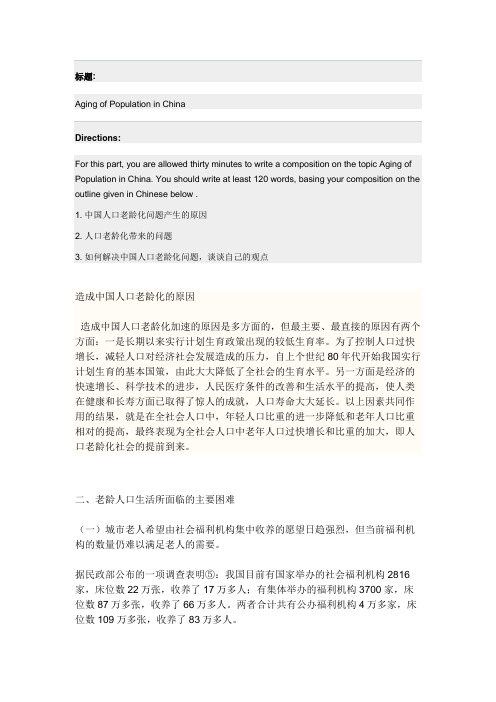
Aging of Population in ChinaFor this part, you are allowed thirty minutes to write a composition on the topic Aging of Population in China. You should write at least 120 words, basing your composition on the outline given in Chinese below .1. 中国人口老龄化问题产生的原因2. 人口老龄化带来的问题3. 如何解决中国人口老龄化问题,谈谈自己的观点造成中国人口老龄化的原因造成中国人口老龄化加速的原因是多方面的,但最主要、最直接的原因有两个方面:一是长期以来实行计划生育政策出现的较低生育率。
为了控制人口过快增长,减轻人口对经济社会发展造成的压力,自上个世纪80年代开始我国实行计划生育的基本国策,由此大大降低了全社会的生育水平。
另一方面是经济的快速增长、科学技术的进步,人民医疗条件的改善和生活水平的提高,使人类在健康和长寿方面已取得了惊人的成就,人口寿命大大延长。
以上因素共同作用的结果,就是在全社会人口中,年轻人口比重的进一步降低和老年人口比重相对的提高,最终表现为全社会人口中老年人口过快增长和比重的加大,即人口老龄化社会的提前到来。
二、老龄人口生活所面临的主要困难(一)城市老人希望由社会福利机构集中收养的愿望日趋强烈,但当前福利机构的数量仍难以满足老人的需要。
据民政部公布的一项调查表明⑤:我国目前有国家举办的社会福利机构2816家,床位数22万张,收养了17万多人;有集体举办的福利机构3700家,床位数87万多张,收养了66万多人。
两者合计共有公办福利机构4万多家,床位数109万多张,收养了83万多人。
这与我国数以亿计的福利服务对象(老年人口1.3亿多,还有数百万的孤残儿童和“三无”残疾人)相比,集中收养的床位数只占0.7%多一点,而集中收养的人数则不足0.6%,与发达国家一般集中收养人数占5-7%的比例相差甚远。
中 国人口老龄化问题解决措施英语作文
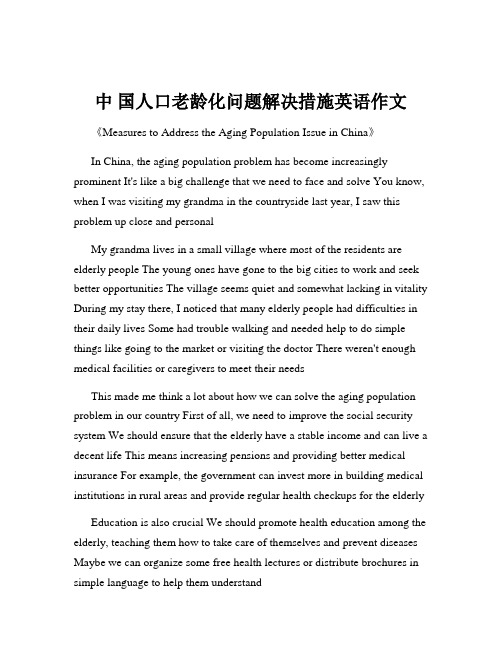
中国人口老龄化问题解决措施英语作文《Measures to Address the Aging Population Issue in China》In China, the aging population problem has become increasingly prominent It's like a big challenge that we need to face and solve You know, when I was visiting my grandma in the countryside last year, I saw this problem up close and personalMy grandma lives in a small village where most of the residents are elderly people The young ones have gone to the big cities to work and seek better opportunities The village seems quiet and somewhat lacking in vitality During my stay there, I noticed that many elderly people had difficulties in their daily lives Some had trouble walking and needed help to do simple things like going to the market or visiting the doctor There weren't enough medical facilities or caregivers to meet their needsThis made me think a lot about how we can solve the aging population problem in our country First of all, we need to improve the social security system We should ensure that the elderly have a stable income and can live a decent life This means increasing pensions and providing better medical insurance For example, the government can invest more in building medical institutions in rural areas and provide regular health checkups for the elderlyEducation is also crucial We should promote health education among the elderly, teaching them how to take care of themselves and prevent diseases Maybe we can organize some free health lectures or distribute brochures in simple language to help them understandAnother important aspect is to develop elderly care services We can establish more nursing homes and community care centers, especially in areas where the elderly population is concentrated These places should have professional caregivers who can provide roundtheclock care and support Also, we can encourage volunteer activities to help the elderly For instance, young people can spend their weekends visiting the elderly, chatting with them, and helping them with houseworkIn addition, we need to create more job opportunities in rural areas and small towns to attract young people to stay This way, families can be together, and the elderly can get care and company from their children Maybe the government can offer some incentives for businesses to set up in these areas, such as tax breaks or subsidiesTechnology can also play a big role We can develop smart devices and apps specifically for the elderly to make their lives more convenient For example, there could be apps that remind them to take medicine or connect them with doctors for online consultationsFinally, we should encourage the elderly to stay active and engaged in society We can set up more elderly activity centers where they can learn new skills, do hobbies, and make friends This not only enriches their lives but also helps them stay healthy both physically and mentallyIn conclusion, solving the aging population problem in China requires the joint efforts of the government, society, and individuals Only by taking various measures and paying attention to the needs of the elderly can we create a better life for them and ensure the sustainable development of our society Let's all work together to make this happen!。
中国老龄化作文英文作文
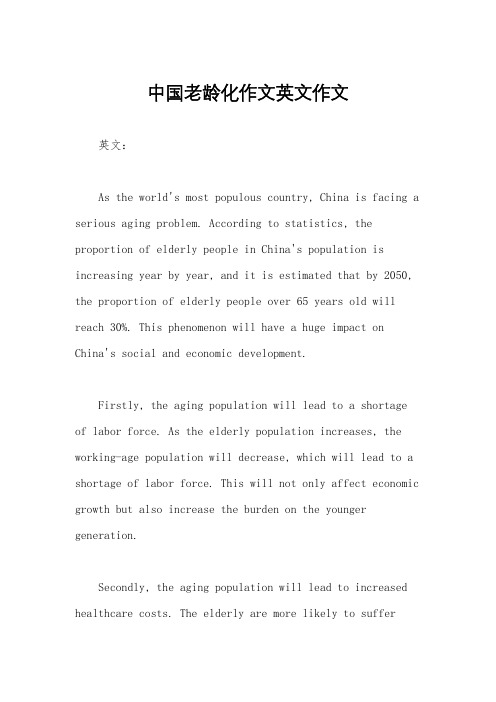
中国老龄化作文英文作文英文:As the world's most populous country, China is facing a serious aging problem. According to statistics, the proportion of elderly people in China's population is increasing year by year, and it is estimated that by 2050, the proportion of elderly people over 65 years old will reach 30%. This phenomenon will have a huge impact on China's social and economic development.Firstly, the aging population will lead to a shortage of labor force. As the elderly population increases, the working-age population will decrease, which will lead to a shortage of labor force. This will not only affect economic growth but also increase the burden on the younger generation.Secondly, the aging population will lead to increased healthcare costs. The elderly are more likely to sufferfrom chronic diseases and require more medical treatmentand care. This will increase the burden on the healthcare system and lead to higher healthcare costs.Thirdly, the aging population will lead to changes in consumer behavior. The elderly have different consumption patterns than younger people. They tend to spend more on healthcare, travel, and leisure activities. This will havea significant impact on the economy, as businesses willneed to adapt to the changing consumer behavior.In order to address the aging problem, the Chinese government has implemented a series of policies, such as increasing the retirement age, improving the healthcare system, and promoting family planning. However, more needsto be done to address this issue.中文:作为世界上人口最多的国家,中国正面临着严重的老龄化问题。
人口老龄化高中英语作文_高中英语作文_
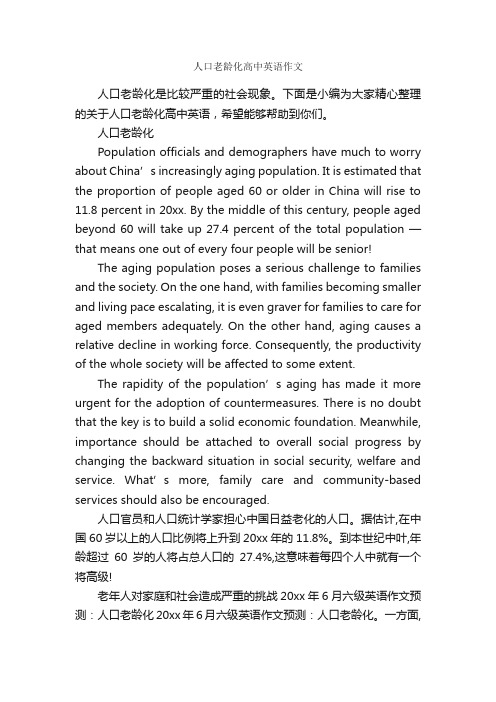
人口老龄化高中英语作文人口老龄化是比较严重的社会现象。
下面是小编为大家精心整理的关于人口老龄化高中英语,希望能够帮助到你们。
人口老龄化Population officials and demographers have much to worry about China’s increasingly aging population. It is estimated that the proportion of people aged 60 or older in China will rise to 11.8 percent in 20xx. By the middle of this century, people aged beyond 60 will take up 27.4 percent of the total population —that means one out of every four people will be senior!The aging population poses a serious challenge to families and the society. On the one hand, with families becoming smaller and living pace escalating, it is even graver for families to care for aged members adequately. On the other hand, aging causes a relative decline in working force. Consequently, the productivity of the whole society will be affected to some extent.The rapidity of the population’s aging has made it more urgent for the adoption of countermeasures. There is no doubt that the key is to build a solid economic foundation. Meanwhile, importance should be attached to overall social progress by changing the backward situation in social security, welfare and service. What’s more, family care and community-based services should also be encouraged.人口官员和人口统计学家担心中国日益老化的人口。
中国人口老龄化英语作文(精选11篇)
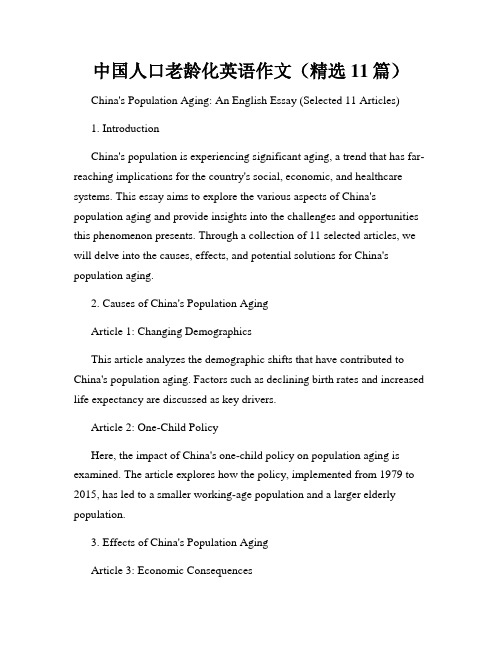
中国人口老龄化英语作文(精选11篇)China's Population Aging: An English Essay (Selected 11 Articles)1. IntroductionChina's population is experiencing significant aging, a trend that has far-reaching implications for the country's social, economic, and healthcare systems. This essay aims to explore the various aspects of China's population aging and provide insights into the challenges and opportunities this phenomenon presents. Through a collection of 11 selected articles, we will delve into the causes, effects, and potential solutions for China's population aging.2. Causes of China's Population AgingArticle 1: Changing DemographicsThis article analyzes the demographic shifts that have contributed to China's population aging. Factors such as declining birth rates and increased life expectancy are discussed as key drivers.Article 2: One-Child PolicyHere, the impact of China's one-child policy on population aging is examined. The article explores how the policy, implemented from 1979 to 2015, has led to a smaller working-age population and a larger elderly population.3. Effects of China's Population AgingArticle 3: Economic ConsequencesThis article investigates the economic repercussions of China's population aging. It highlights concerns such as a shrinking labor force, increased healthcare expenditures, and strains on pension systems.Article 4: Social ChallengesIn this article, the social challenges stemming from population aging are discussed. Topics explored include the need for elderly care facilities, changing family structures, and intergenerational tensions.4. Healthcare ImplicationsArticle 5: Healthcare System StrainsHere, the strain on China's healthcare system due to population aging is examined. The article discusses the increased demand for healthcare services and the need for reforms to adequately support the elderly population.Article 6: Chronic Disease BurdenThis article focuses on the burden of chronic diseases associated with population aging. It highlights the importance of preventative measures and healthcare policies to address the growing healthcare needs of the aging population.5. Solutions for China's Population AgingArticle 7: Social Security ReformsThis article explores potential social security reforms to address the challenges posed by population aging. It discusses ideas such as raising the retirement age, increasing contributions to pension systems, and implementing long-term care insurance.Article 8: Technological InnovationsHere, the role of technology in mitigating the impact of population aging is discussed. The article explores how advancements in robotics and assistive technologies can enhance elderly care and improve the quality of life for older adults.6. International Perspectives on Population AgingArticle 9: Lessons from JapanThis article offers insights from Japan, a country that has been grappling with population aging for several decades. It examines Japan's policies and initiatives that could serve as valuable lessons for China.Article 10: European ApproachesHere, the article explores how European countries have addressed population aging. It highlights policy initiatives, such as active aging programs and intergenerational solidarity, that could be adapted to the Chinese context.7. ConclusionIn conclusion, China's population aging is a multifaceted issue with wide-ranging implications. As discussed in the selected articles, it is crucial for the Chinese government and society to address the challenges posed by population aging through comprehensive policies and innovative solutions. By doing so, China can unlock the potential opportunities that come with an aging population and ensure a sustainable future for all its citizens.(Note: Word count: 467)。
六级英语人口老龄化作文

六级英语人口老龄化作文六级英语人口老龄化作文导语:人口老龄化问题越来越一严重,小编收集有关人口老龄化的英语作文,欢迎阅读。
第一篇:Population officials and demographers have much to worry about China’s increasingly aging population. It is estimated that the proportion of people aged 60 or older in China will rise to 11.8 percent in 2020. By the middle of this century, people aged beyond 60 will take up 27.4 percent of the total population —that means one out of every four people will be senior!The aging population poses a serious challenge to families and the society. On the one hand, with families becoming smaller and living pace escalating, it is even graver for families to care for aged members adequately. On the other hand, aging causes a relative decline in working force. Consequently, the productivity of the whole society will be affected to some extent.The rapidity of the population’s aging has made it more urgent for the adoption of countermeasures. There is no doubt that the key is to build a solid economic foundation. Meanwhile, importance should be attached to overall social progress by changing the backward situation in social security, welfare and service. What’s more, family care and community-based services should also be encouraged.翻译:人口官员和人口统计学家担心中国日益老化的人口。
关于中国老龄化的英语作文

关于中国老龄化的英语作文Title: The Aging Population in China: Challenges and OpportunitiesIntroduction China, the most populous country in the world, is facing a significant demographic shift. The aging population has become a prominent issue that requires urgent attention and strategic planning. This essay will discuss the challenges and opportunities brought about by this phenomenon.Body Paragraph 1: The Challenges of an Aging Population One of the main challenges associated with an aging population is the increased demand for healthcare services. As people age, they are more likely to develop chronic conditions and disabilities, which can strain the already overwhelmed medical system. Additionally, there may be a shortage of skilled healthcare workers to cater to the needs of the elderly.Another challenge is the economic impact. An aging population means fewer people in the workforce, which could lead to reduced productivity and economic growth. Moreover, the government may face higher expenditures on pensions and healthcare for retirees.Body Paragraph 2: The Opportunities of an Aging Population Despite these challenges, an aging population also presents opportunities for innovation and entrepreneurship. For instance, there is a growing market for products and services tailored to the needs of older adults, such as assistive technologies, home care services, and wellness programs. This could spur job creation and economic development in related industries.Furthermore, an aging population can contribute positively to society by sharing their knowledge and experiences with younger generations. They can serve as mentors, volunteers, or even entrepreneurs themselves, thereby enriching the community's cultural heritage and social fabric.Conclusion In conclusion, while China's aging population poses several challenges, it also offers potential benefits if managed effectively. It is crucial for policymakers to implement strategies that address the needs of the elderly while harnessing their potential contributions to society. By doing so, China can ensure a sustainable future for its rapidly aging population.。
中国老龄化英语作文带翻译
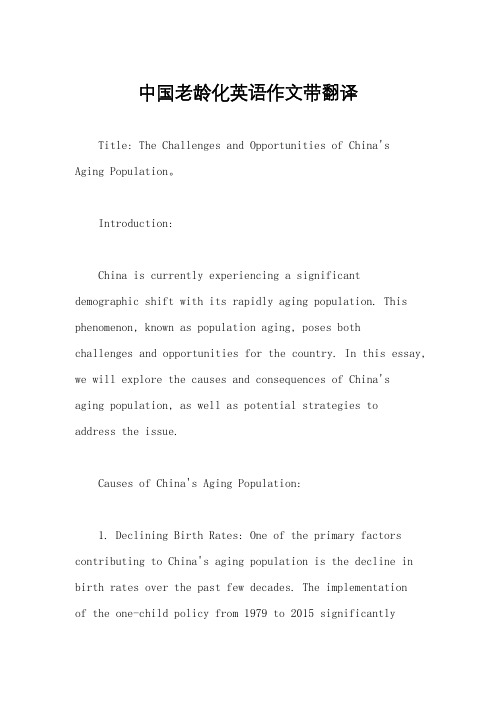
中国老龄化英语作文带翻译Title: The Challenges and Opportunities of China'sAging Population。
Introduction:China is currently experiencing a significant demographic shift with its rapidly aging population. This phenomenon, known as population aging, poses bothchallenges and opportunities for the country. In this essay, we will explore the causes and consequences of China'saging population, as well as potential strategies toaddress the issue.Causes of China's Aging Population:1. Declining Birth Rates: One of the primary factors contributing to China's aging population is the decline in birth rates over the past few decades. The implementationof the one-child policy from 1979 to 2015 significantlyreduced the number of births in the country, leading to a smaller younger population.2. Increased Life Expectancy: Another contributing factor is the significant increase in life expectancy due to improved healthcare and living conditions. As peoplelive longer, the proportion of elderly individuals in the population naturally increases.Consequences of China's Aging Population:1. Economic Impact: The aging population poses significant economic challenges for China. With a shrinking workforce and a larger elderly population, there is astrain on the social security system and healthcare resources. The burden on the working-age population to support the elderly through pensions and healthcare costs becomes more substantial.2. Healthcare and Social Welfare: The aging population requires increased healthcare services and social welfare support. The demand for medical facilities, long-term care,and retirement homes will surge, placing pressure on the healthcare system and government resources.3. Labor Market and Productivity: As the working-age population declines, labor shortages may arise in certain industries. This could potentially lead to a decrease in productivity and economic growth. It becomes crucial for China to adapt its labor market policies to address these challenges.4. Family Structure: Traditionally, Chinese families have relied on the support of multiple generations. However, as the younger generation faces increased economic pressure and mobility, the traditional family structure may undergo significant changes. This could affect the social fabricand support networks for the elderly.Strategies to Address China's Aging Population:1. Encouraging Birth Rates: To counter the declining birth rates, the Chinese government has relaxed the one-child policy to a two-child policy in 2016. Furthermeasures could be implemented to incentivize couples to have more children, such as improved maternity andpaternity leave policies, affordable childcare, and increased financial support for families.2. Healthcare and Social Welfare Reforms: China needs to invest in its healthcare and social welfare systems to accommodate the growing needs of the elderly population. This includes improving access to healthcare services, expanding long-term care facilities, and providingfinancial assistance for elderly care.3. Promoting Active Aging: Encouraging active aging through policies and programs can help older adults stay physically and mentally active, allowing them to contribute to society and delay dependency. This can be achieved through initiatives such as lifelong learning programs, employment opportunities for older adults, and community engagement.4. Technology and Innovation: Embracing technological advancements can help alleviate some of the challengesposed by an aging population. Smart healthcare systems, assistive technologies, and telemedicine can improve healthcare access and quality for the elderly. Additionally, automation and artificial intelligence can help addresslabor shortages and enhance productivity.Conclusion:China's aging population presents both challenges and opportunities for the country. While the economic andsocial implications are significant, proactive measures can be taken to mitigate the negative consequences and leverage the potential benefits. By implementing strategies to encourage birth rates, improving healthcare and social welfare systems, promoting active aging, and embracing technology, China can navigate the path towards a more sustainable and inclusive society for all generations.。
中国老龄化 英文作文

中国老龄化英文作文英文:As a Chinese citizen, I am deeply concerned about the issue of China's aging population. According to statistics, the proportion of people over 65 years old in China's population will reach 30% by 2050, which means that China will become an aging society. This trend is caused by several factors, such as the one-child policy, improved healthcare and living standards, and the decrease infertility rate.The aging population will bring many challenges to China's economic and social development. For example, the burden of caring for the elderly will be heavier, and the demand for healthcare services will increase. Moreover, the labor force will shrink, which will affect economic growth and productivity. To address these challenges, China needs to take measures to promote the development of the elderly care industry, encourage fertility, and improve the qualityof healthcare services.In my opinion, the government should provide more support and incentives for families to have more children, such as tax breaks and subsidies. At the same time, the government should also invest more in the elderly care industry, including building more nursing homes andtraining more caregivers. In addition, the governmentshould encourage the development of technology and innovation to improve the efficiency and quality of healthcare services.中文:作为一名中国公民,我非常关注中国老龄化问题。
人口老龄化英语作文4级

The Challenges and Opportunities ofPopulation Aging in ChinaPopulation aging is a global trend, but it is particularly evident in China. With the rapid economic development and changing demographic structure, the elderly population in China is growing rapidly, posing both challenges and opportunities for society.The aging population in China is mainly due to two factors. Firstly, with the implementation of the one-child policy, the birth rate has dropped significantly, resulting in a smaller workforce and a larger elderly population. Secondly, the improvement of medical technology and health care services has led to an increase in life expectancy, further accelerating the aging process.One of the main challenges posed by the aging population is the pressure on the social security system. As the number of elderly people increases, the demand for pensions, health care, and long-term care services also rises sharply. This places a huge financial burden on the government and society, which needs to be addressed through reforms and sustainable financing mechanisms.Another challenge is the impact on the labor market.The aging population leads to a decrease in the labor force, which may affect economic growth and productivity. To counter this, China needs to promote structural reforms, improve the efficiency of the labor market, and encourage innovation and technological progress.However, the aging population also brings opportunities for China. Firstly, the elderly population is a valuable resource for society. With their wealth of experience and wisdom, they can contribute to social development and cultural传承. The government and society should createmore opportunities for the elderly to participate in social activities and volunteer work, promoting intergenerational communication and understanding.Secondly, the aging population drives the developmentof related industries. The demand for health care, pensions, and long-term care services creates business opportunities for the private sector. By innovating and improving the quality of services, enterprises can meet the needs of the elderly and achieve sustainable development.In conclusion, population aging in China presents both challenges and opportunities. To address the challenges,the government and society need to work together to reform the social security system, improve the efficiency of the labor market, and create more opportunities for the elderly. At the same time, we should seize the opportunities brought by the aging population, promoting intergenerational communication and understanding, and driving the development of related industries. Only through comprehensive and sustainable strategies can we ensure that population aging becomes a positive force for social progress and development.**中国人口老龄化的挑战与机遇**人口老龄化是全球趋势,但在中国尤为明显。
浙江专升本真题中国人口老龄化英语作文
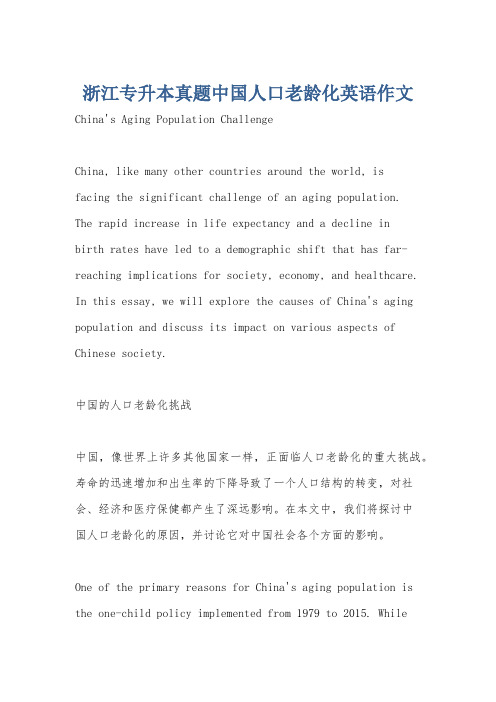
浙江专升本真题中国人口老龄化英语作文China's Aging Population ChallengeChina, like many other countries around the world, isfacing the significant challenge of an aging population.The rapid increase in life expectancy and a decline inbirth rates have led to a demographic shift that has far-reaching implications for society, economy, and healthcare. In this essay, we will explore the causes of China's aging population and discuss its impact on various aspects of Chinese society.中国的人口老龄化挑战中国,像世界上许多其他国家一样,正面临人口老龄化的重大挑战。
寿命的迅速增加和出生率的下降导致了一个人口结构的转变,对社会、经济和医疗保健都产生了深远影响。
在本文中,我们将探讨中国人口老龄化的原因,并讨论它对中国社会各个方面的影响。
One of the primary reasons for China's aging population is the one-child policy implemented from 1979 to 2015. Whilethis policy aimed to control population growth, it also resulted in a rapid decline in fertility rates. As a result, there are now fewer young people entering the workforce to support and care for the elderly. This puts immensepressure on the working-age population who have to shoulder not only their own financial responsibilities but also support their aging parents.中国人口老龄化的主要原因之一是从1979年至2015年实施的独生子女政策。
中国老龄化英语作文
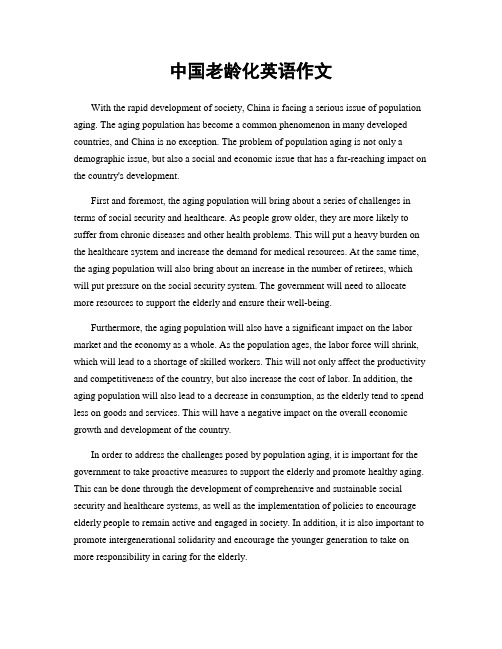
中国老龄化英语作文With the rapid development of society, China is facing a serious issue of population aging. The aging population has become a common phenomenon in many developed countries, and China is no exception. The problem of population aging is not only a demographic issue, but also a social and economic issue that has a far-reaching impact on the country's development.First and foremost, the aging population will bring about a series of challenges in terms of social security and healthcare. As people grow older, they are more likely to suffer from chronic diseases and other health problems. This will put a heavy burden on the healthcare system and increase the demand for medical resources. At the same time, the aging population will also bring about an increase in the number of retirees, which will put pressure on the social security system. The government will need to allocate more resources to support the elderly and ensure their well-being.Furthermore, the aging population will also have a significant impact on the labor market and the economy as a whole. As the population ages, the labor force will shrink, which will lead to a shortage of skilled workers. This will not only affect the productivity and competitiveness of the country, but also increase the cost of labor. In addition, the aging population will also lead to a decrease in consumption, as the elderly tend to spend less on goods and services. This will have a negative impact on the overall economic growth and development of the country.In order to address the challenges posed by population aging, it is important for the government to take proactive measures to support the elderly and promote healthy aging. This can be done through the development of comprehensive and sustainable social security and healthcare systems, as well as the implementation of policies to encourage elderly people to remain active and engaged in society. In addition, it is also important to promote intergenerational solidarity and encourage the younger generation to take on more responsibility in caring for the elderly.In conclusion, the issue of population aging is a complex and multifaceted issue that requires a comprehensive and coordinated response from the government, civil society, and the private sector. By addressing the challenges posed by population aging, China can ensure the well-being of its elderly population and promote sustainable development for the future. It is important for all sectors of society to work together to address this issue and ensure a better future for all.。
中国老龄化英语作文
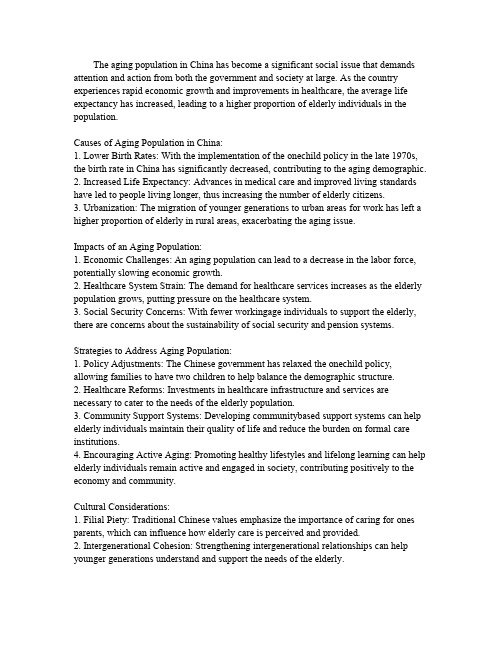
The aging population in China has become a significant social issue that demands attention and action from both the government and society at large.As the country experiences rapid economic growth and improvements in healthcare,the average life expectancy has increased,leading to a higher proportion of elderly individuals in the population.Causes of Aging Population in China:1.Lower Birth Rates:With the implementation of the onechild policy in the late1970s, the birth rate in China has significantly decreased,contributing to the aging demographic.2.Increased Life Expectancy:Advances in medical care and improved living standards have led to people living longer,thus increasing the number of elderly citizens.3.Urbanization:The migration of younger generations to urban areas for work has left a higher proportion of elderly in rural areas,exacerbating the aging issue.Impacts of an Aging Population:1.Economic Challenges:An aging population can lead to a decrease in the labor force, potentially slowing economic growth.2.Healthcare System Strain:The demand for healthcare services increases as the elderly population grows,putting pressure on the healthcare system.3.Social Security Concerns:With fewer workingage individuals to support the elderly, there are concerns about the sustainability of social security and pension systems.Strategies to Address Aging Population:1.Policy Adjustments:The Chinese government has relaxed the onechild policy, allowing families to have two children to help balance the demographic structure.2.Healthcare Reforms:Investments in healthcare infrastructure and services are necessary to cater to the needs of the elderly population.munity Support Systems:Developing communitybased support systems can help elderly individuals maintain their quality of life and reduce the burden on formal care institutions.4.Encouraging Active Aging:Promoting healthy lifestyles and lifelong learning can help elderly individuals remain active and engaged in society,contributing positively to the economy and community.Cultural Considerations:1.Filial Piety:Traditional Chinese values emphasize the importance of caring for ones parents,which can influence how elderly care is perceived and provided.2.Intergenerational Cohesion:Strengthening intergenerational relationships can help younger generations understand and support the needs of the elderly.Future Outlook:The aging population in China presents both challenges and opportunities.It requires a multifaceted approach that includes policy changes,economic adjustments,and social support systems to ensure that the elderly can live with dignity and that society can continue to thrive.As China adapts to this demographic shift,it can serve as a model for other countries facing similar issues.。
2015年英语六级作文范文(3):人口老龄化

题目要求:1. 我国人口老龄化现象日趋明显2. 人口老龄化带来的问题3. 如何妥善解决人口老龄化问题参考范文:Aging of the PopulationPopulation officials and demographers have much to worry about China’s increasingly aging population. It is estimated that the proportion of people aged 60 or older in China will rise to 11.8 percent in 2020. By the middle of this century, people aged beyond 60 will take up 27.4 percent of the total population —that means one out of every four people will be senior!The aging population poses a serious challenge to families and the society. On the one hand, with families becoming smaller and living pace escalating, it is even graver for families to care for aged members adequately. On the other hand, aging causes a relative decline in working force. Consequently, the productivity of the whole society will be affected to some extent.The rapidity of the population’s aging has made it more urgent for the adoption of countermeasures. There is no doubt that the key is to build a solid economic foundation. Meanwhile, importance should be attached to overall social progress by changing the backward situation in social security, welfare and service. What’s more, family care and community-based services should also be encouraged.。
人口老龄化英语作文(精选17篇)
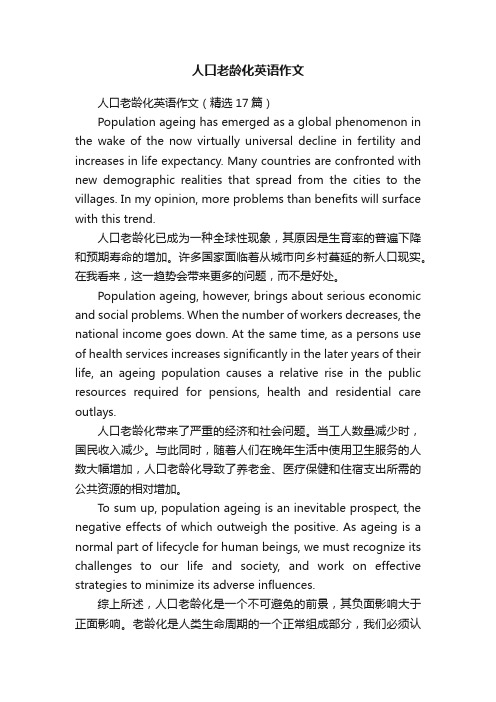
人口老龄化英语作文人口老龄化英语作文(精选17篇)Population ageing has emerged as a global phenomenon in the wake of the now virtually universal decline in fertility and increases in life expectancy. Many countries are confronted with new demographic realities that spread from the cities to the villages. In my opinion, more problems than benefits will surface with this trend.人口老龄化已成为一种全球性现象,其原因是生育率的普遍下降和预期寿命的增加。
许多国家面临着从城市向乡村蔓延的新人口现实。
在我看来,这一趋势会带来更多的问题,而不是好处。
Population ageing, however, brings about serious economic and social problems. When the number of workers decreases, the national income goes down. At the same time, as a persons use of health services increases significantly in the later years of their life, an ageing population causes a relative rise in the public resources required for pensions, health and residential care outlays.人口老龄化带来了严重的经济和社会问题。
英语作文:关于中国人口老龄化ChinasPopulationAging(通用9篇)

英语作文:中国人口老龄化Chinas Population Aging英语作文:关于中国人口老龄化Chinas Population Aging(通用9篇)要想写好作文,优秀的题材是少不了的,所以平常要多少读书,多看看作文,积累知识,才能写出好的作文,下面是小编精心整理的英语作文:中国人口老龄化Chinas Population Aging,希望对你有帮助!英语作文:中国人口老龄化Chinas Population Aging 篇1 提纲1.中国已成为老龄化国家。
2.老年人的生活现状。
China has become a country with an increasing number of old people. By old people we usually mean persons over the age of sixty. We often call them senior citizens instead of old men to show our respect.中国已经变成一个老年人越来越多的国家。
我们通常把年纪超过六十岁的人称为老年人。
为了表示我们对他们的尊重,我们经常称他们为退休者而不是老年人。
Most senior citizens retire or no longer work full-time. They usually live in their own houses not far from their children's, while the children of a few senior citizens have gone abroad and work or study far beyond the oceans. For certain senior citizens, tile years after retirement are not very enjoyable. First, they feel that their lives lose meaning for being at home all day. In addition, they may feel lonely, especially those without children around. Moreover, they become more concerned with their health, as they grow older, and worry a lot about their safety. At the same time, many senior citizens enjoy their lives. They feel free to do things they were not able to do when they were working andraising their families. They spend their time travelling, doing exercises or watching TV. They get together with their fellow members who have the common interests and equal free time.大多数的老人退休或不再做全职工作。
英语作文:关于中国人口老龄化China's Population Aging
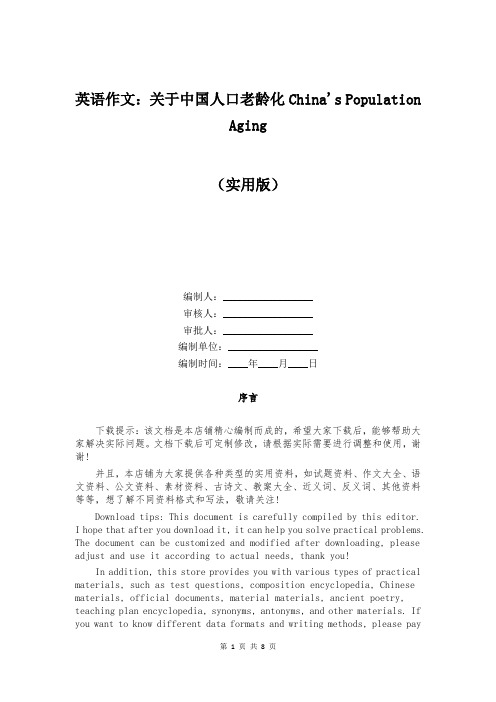
英语作文:关于中国人口老龄化China's PopulationAging(实用版)编制人:__________________审核人:__________________审批人:__________________编制单位:__________________编制时间:____年____月____日序言下载提示:该文档是本店铺精心编制而成的,希望大家下载后,能够帮助大家解决实际问题。
文档下载后可定制修改,请根据实际需要进行调整和使用,谢谢!并且,本店铺为大家提供各种类型的实用资料,如试题资料、作文大全、语文资料、公文资料、素材资料、古诗文、教案大全、近义词、反义词、其他资料等等,想了解不同资料格式和写法,敬请关注!Download tips: This document is carefully compiled by this editor.I hope that after you download it, it can help you solve practical problems. The document can be customized and modified after downloading, please adjust and use it according to actual needs, thank you!In addition, this store provides you with various types of practical materials, such as test questions, composition encyclopedia, Chinese materials, official documents, material materials, ancient poetry, teaching plan encyclopedia, synonyms, antonyms, and other materials. If you want to know different data formats and writing methods, please payattention!英语作文:关于中国人口老龄化China's Population Aging篇一:Chinese Senior Citizen提纲1.中国已成为老龄化国家。
关于中国老龄化问题的英语作文

关于中国老龄化问题的英语作文China's Aging Population: Challenges and OpportunitiesThe rapid aging of China's population has become a significant concern in recent years. As the country experiences a decline in fertility rates and an increase in life expectancy, the proportion of elderly individuals within the population is steadily rising. This demographic shift presents both challenges and opportunities for China, and it is crucial to address the issue proactively to ensure the well-being of the aging population and the stability of the nation as a wholeOne of the primary challenges posed by China's aging population is the strain on the healthcare system. With a growing number of elderly individuals requiring medical attention, the demand for healthcare services is increasing exponentially. This has put a significant strain on the healthcare infrastructure, leading to long wait times, overcrowded hospitals, and a shortage of specialized geriatric care. Additionally, the cost of providing healthcare to the elderly population has become a significant financial burden for both the government and individual familiesAnother challenge is the impact on the labor force and economic productivity. As the population ages, the ratio of working-age individuals to retirees decreases, putting pressure on the social security system and the overall economic sustainability of the country. This can lead to labor shortages, a decline in economic growth, and an increased dependency on the younger generation to support the elderlyFurthermore, the aging population has implications for the social fabric of Chinese society. Traditional family structures, where the younger generation cared for their elderly parents, are gradually being eroded as more individuals migrate to urban areas for employment opportunities. This has led to a rise in the number of elderly individuals living alone or in nursing homes, which can result in feelings of isolation and a lack of social supportDespite these challenges, China's aging population also presents opportunities for the country to develop innovative solutions and explore new avenues for economic growth. For instance, the healthcare industry has the potential to become a significant driver of economic development as the demand for medical services and products increases. This could lead to the emergence of new technologies, treatments, and healthcare-related businesses that cater to the needs of the elderly populationAdditionally, the aging population could be a catalyst for the development of the service sector, particularly in areas such as elderly care, recreational activities, and leisure services. This could create new job opportunities and contribute to the diversification of the economyMoreover, the experience and wisdom of the elderly population can be leveraged to support the younger generation. Older individuals can serve as mentors, sharing their knowledge and expertise in various fields, and contributing to the overall development of the countryTo effectively address the challenges posed by China's aging population, a comprehensive and multifaceted approach is necessary. This includes investing in the healthcare system to improve the quality and accessibility of geriatric care, implementing policies to support the elderly and their families, and promoting the integration of the elderly into the social and economic fabric of the countryFurthermore, the government should prioritize the development of a robust social security system that can provide financial security and support for the elderly population. This could include measures such as increasing pension benefits, improving access to affordable housing, and ensuring the availability of long-term care facilitiesAdditionally, the promotion of active and healthy aging should be a key focus. This can be achieved through the development of programs that encourage physical activity, social engagement, and lifelong learning among the elderly population. By empowering the elderly to maintain their independence and participate actively in their communities, China can harness the potential of its aging population and ensure their well-beingIn conclusion, China's aging population presents both challenges and opportunities for the country. By addressing the issues proactively and implementing comprehensive strategies, China can transform the demographic shift into a positive force for economic and social development. Through innovative solutions, targeted policies, and a renewed focus on the well-being of the elderly, China can ensure a brighter future for its aging population and the nation as a whole。
中国人口老龄化英语作文

From what has been mentioned, we can come to the conclusion thatwe cannot emphasize the importance of aging too much.Only in this way can we solve the problem of populatiowadays, the problem of aging population is becoming much more serious in China. In addition, the amount of empty nesters is increasing rapidly. There are several reasons that caused the phenomenon of empty nesters. First of all, there are more opportunities in the urban areas, young people from the rural areas tend to leave their hometown and settle in the cities. As a result, their aging parents have to live alone. Secondly, facing too much pressure from work and life, young people actually have little time to look after their parents. They have to work day and night before getting paid, and the amount of holiday to rest is quite limited. Thus, the elders become empty-nested. To solve this social problem effectively, both the governments and the whole society should take measures. For the governments, they should emphasize the importance of caring parents by utilizing the popular social media such as WeChat and Weibo, thereby improving our awareness. For the whole society, more volunteers should be gathered in order to look after those empty nesters. By these methods, the problem of empty nesters should be solved gradually.
中国目前老龄化英语作文

中国目前老龄化英语作文China's Aging Population。
With the rapid development of the economy and society, China's population has been growing steadily for many years. However, the aging population has become a serious problemin recent years. According to statistics, the proportion of people over 60 years old in China's population has reached 18.7%, and it is expected to increase to 34.9% by 2050.This trend has brought many challenges to the country's economic and social development.The aging population has a direct impact on the labor force and the economy. As people age, their physicalabilities decline, and they become less productive. This means that the labor force will decrease, which will affect economic growth. In addition, the aging population willalso increase the burden on the social security system, including healthcare, pension, and other social welfare services.Furthermore, the aging population will also affect the family structure and social relationships. In traditional Chinese culture, filial piety is highly valued, andchildren are expected to take care of their aging parents. However, with the one-child policy, many families have only one child to take care of their aging parents, which puts a heavy burden on the younger generation. This may also leadto a decline in social cohesion and interpersonal relationships.To address these challenges, the Chinese government has taken measures to support the aging population. For example, the government has implemented policies to encourage people to have more children, such as relaxing the one-childpolicy and providing financial incentives. The government has also increased investment in healthcare, pension, and other social welfare services to support the aging population.In addition, the government has encouraged the development of the elderly care industry, including nursinghomes, home care services, and other related services. This will provide more options for the elderly and help reduce the burden on their families.In conclusion, China's aging population is a major challenge for the country's economic and social development. The government needs to take effective measures to support the aging population and ensure that they can live a happy and healthy life. At the same time, society as a wholeneeds to promote the concept of filial piety and social responsibility, and work together to create a harmoniousand caring society.。
- 1、下载文档前请自行甄别文档内容的完整性,平台不提供额外的编辑、内容补充、找答案等附加服务。
- 2、"仅部分预览"的文档,不可在线预览部分如存在完整性等问题,可反馈申请退款(可完整预览的文档不适用该条件!)。
- 3、如文档侵犯您的权益,请联系客服反馈,我们会尽快为您处理(人工客服工作时间:9:00-18:30)。
中国的人口老龄化摘要:由于下降的生育率和上升的寿命率的协同效应,使人口老龄化成为“人口过渡”过程中不可避免的结果。
在老龄化进程中,农村和城市人口有不同程度的老龄化趋势。
人口老龄化也引起社会群体对老人生活安排的注意。
由于传统观念的改变,子女的赡养不再是老人唯一的依靠,更多的是政府和另外一些社会机构对老年人作出的扶助政策。
关键词:人口过渡老龄化趋势生活安排一、引言中国的人口老龄化的直接决定因素基本上也如另外一些国家一样。
由于下降的生育率和上升的寿命率的协同效应,使人口老龄化成为“人口过渡”过程中不可避免的结果。
然而,由于不同的历史,文化,经济和政治背景,所以中国的老龄化明显是特殊的。
随着21世纪前五十年,老年人口比例从 6.8%增长到23.6%,使得老龄化的增长趋势本身就无法匹敌。
作为世界上人口最多的国家,老龄化的人口增长达到了惊人的24,2000,000。
本论文的写作目的是在社会主义的前提下来检测中国老龄化中的诸多方面。
首先我们探索人口决定因素和老龄化趋势,强调国家政策促进了低水平的人口生育率和死亡率。
为了解决老年人的赡养问题,我们调查了传统的家庭照顾体系以及在1987年改革开放政策启动以来所面对的挑战。
然后我们回顾了政府为满足老龄化人口需求所倡导的退休和医疗计划。
然后我们总结了政府在面对平衡经济发展和老龄化扶助安排中的两难窘境。
最后我们将回顾一些政策方案和潜在的机遇来解决二十一世纪的全球人口问题。
二、急剧下降的生育和死亡率模式作为世界上现存最古老的人类社会,中国的人口历史到了二十世纪符合典型的人口过渡模式中的前过渡阶段的描述。
在十七世纪前的一千年中,高生育率和高死亡率的人口体制使人口波动在37,000,000-60,000,000之间,在清朝时首度经历了迅速增长,达到了400,000,000。
然而在1851年至1949年由于内战和帝国主义的侵略造成了社会动乱,使得一口再一度下降。
1949年中华人民共和国的成立标志着人口过渡的开端,这个过程使得中国与其他国家在急剧下降的生育率和死亡率中区分开来,两者都离不开政府的干预。
三、城市和乡村的老龄化趋势低死亡率和低生育率的成功使得人口老龄化加剧。
运用1982年的人口普查中的城市/农村定义,马森认为到2017年15%的城市人口将能达到65岁,然而在农村20年后才会出现该状况。
然而20世纪80年代以来的农村人口迁到城市的行为可能改变这一调查报告。
根据2000年的人口审查表,可作出保守的估计人口会达到79,000,000,把净迁出人口计算在内,马森发现农村老龄化将会越来越多,65岁以上的人口将会达到2009年目前城市的人口状况。
四、生活安排的趋势研究老年人的生活安排有必要去理解亲属是否可以提供赡养。
因为同居于一个屋檐下更可能去提供赡养,即使实际复杂的生活安排和健康,生活安排仍可视为一种幸福指标。
据2000年曾等人收集到的人口普查和调查数据宏观模拟了老年人生活安排的趋势根据平均的生育率、死亡率、农村/城市迁移,结婚和离婚的假设。
即使是保守的估计,他们的计划显示平均人口数量将会从2000年的3.46%锐减到2020年的2.86%和2050年的2.69%。
年龄超过65岁的空巢家庭将会达到2000年的三倍。
五、政府和协会的相关扶助如上诉述的,传统的家庭结构和家庭赡养制度在中国已经历了一些变化。
面对如此已毁坏的非正式的老年支持体系,政府有必要加强其扶助的角色。
我们可以得出三个不同阶段的政策体系,分别是协会帮助,医疗保障和保险和老年社会保障。
六、结论目前正如三十年前一样,人口过多仍是主要问题。
矛盾的是计划生育已经成功地控制人口的增长,另一方面却急剧加速了老龄化进程。
关注点从太多孩子去赡养变成太少孩子去赡养迅速老化的人口。
由于下降的依靠比率和上升的健康医疗和社会保障计划,中国正处于满足老龄化需求的巨大压力中。
这是一个极具挑战性的问题,因为中国人均收入水平是同样面对人口老龄化的发达国家四分之一而已。
因此中国将同时面临经济发展和人口老龄化处理的双重难题。
中国将怎样解决在致富之前先治老龄化,又是谁将会照顾这些老人呢?在中国已经延续了几个世纪的孝道深植于文化传统中。
尽管最近几年有所毁损,但仍难以置信它将在不久后瓦解消亡。
有许多证据表明中国的父母和子女间有着紧密的联系和两代间的凝聚力。
而且政府也在努力来保护传统价值和巩固家庭义务。
在未来的几十年里,家庭赡养体系仍然是一个不可或缺的角色来承担照顾老人的责任。
政府和家庭的联手努力或许是解决长期老龄化问题的最好方案。
Population Aging in China1 IntroductionThe proximate determinants of population aging in China are fundamentally the same as those in any other country. It is an inevitable consequence of the process known as the “demographic transition”in which declining fertility together with a rise in life expectancy leads to a shift towards an older age structure of the population. Yet, the story of population aging in China is unmistakably unique, shaped by its distinct historical, cultural, economic and political contexts. The pace of its aging trend is by itself unparalleled, with the proportion of older adults projected to grow from 6.8 per cent to 23.6 per cent over the first half of the twenty-first century (United Nations 2005). As the most populous country in the world, this increase in the population of elderly translates to an astounding growth of 242 million people, which would qualify itIt is the purpose of this chapter to examine the multifaceted process of population aging in China, with particular attention to its socialist/communist background. We begin by exploring the demographic determinants and trends of population aging, highlighting the role of state policies in facilitating the fertility and mortality declines. To address the issue of elderly caregiving, we examine the traditional family support system and the challenges it faces since the launch of the economic reform policies in 1978. We then review the on-going pension and health care reforms initiated by the government as strategies to meet the demands of an aging population. In the conclusion, we discuss the dilemma that the government faces in balancing economic development and providing adequate old-age support. Lastly, we review some alternative policy options and potential opportunities China may have in addressing this global population problem of the 21 st century.2 An Accelerated Model of Mortality and Fertility DeclineAs one of the oldest human societies in existence, China’s population history up to the twentieth century fits the description of the pre-transitional stage of the classic model of demographic transition. Under a high fertility and high mortality regime, the population fluctuated between 37 and 60 million in size for over a thousand years prior to the 17 th century; then for the first time experienced rapid growth and reached a size of over 400 million during the reign of the Qing Dynasty (1749–1851); but then had its growth slowed again between 1851 and 1949 as a consequence of the social turmoil caused by civil wars and imperialist invasions (Banister 1992). The establishment of the People’s Republic of China in 1949 marked the beginning of its demographic transition, a process that distinguished China from the rest of world due to its extraordinarily rapid declines of mortality and fertility (see Fig. 8.1), neither of which would have been possible without strong government intervention.3 The Trend of Population Aging in Urban and Rural ChinaThe very success of China’s mortality and fertility decline has accelerated the process of population aging in China. Using the urban/rural definition from the 1982 population census, Wang and Mason (2007) projected that 15 per cent of the urban population would be 65 years and older in 2017, while the same figure would not be achieved in rural China until twenty years later. However, massive rural to urban migration that started in the 1980s may very well change the scenario. It was conservatively estimated that the size of the “floating population”(“temporary”migrants) reached nearly 79 million, according to the 2000 census tabulation (Liang and Ma 2004). Taking net out-migration into account, Wang and Mason (Forthcoming) found that aging in rural China would occur much faster and sooner, with the proportion of the population aged 65+ reaching the level of the current urban population as early as 2009.4 Trend of Living ArrangementsStudies on living arrangements of the elderly population are essential tounderstand the structure of kin availability for support. Because coresidence with family members often means they are more likely to receive support, living arrangements were often viewed as an indicator for well-being, despite mixed empirical findings on the relationship between living arrangements and health (Lawton et al. 1984; Sarwari et al. 1998; Zunzunegui et al. 2001).Using census and survey data collected around2000, Zeng et al. (Forthcoming) macro-simulated thetrend in elderly living arrangements under the mediumassumptions on fertility, mortality, rural-urban migration,marriage and divorce. Despite being a conservativeestimate (given that it does not take changingpreference into account), their projection showed thatthe average household size would decrease from 3.46persons per household in 2000 to 2.86 in 2020 and 2.69in 2050 and that the proportion of the elderly aged 65+ living in “empty-nest”households would triple that of the 2000 level.5 Government and Institutional Support for ElderlyAs described above, the traditional family structureand family support system has undergone some major shifts in China. Facing the possibility of an undermined informal old age support system, it is imperative for the government to strengthen its role in public support. In the following section we outline three systems at different stages of policy development, including institutionalized care, health care and health insurance and old age social security.6 ConclusionAs recently as three decades ago, China’s primary population problem was overpopulation. Paradoxically, successful implementation of the family planning policy has effectively controlled the population size but drastically speeded up the aging process, thereby shifting the concern from “too many children to support”to “too few children to support a rapidly aging population”(Kaneda 2006). With a falling dependency ratio and an increasing burden on the health care and socialsecurity programs, China is under enormous pressure to meet the demands of an aging society. This is a particularly challenging issue because its per capita income level is less than that of a quarter of the other aging but more developed nations (Population Reference Bureau 2006). China is thus confronting the concurrent tasks of economic development and dealing with population aging. How will China respond to the issue of “growing gray before growing rich”? Who will take care of the elderly?Finally, the deeply rooted cultural tradition of filial piety existed for centuries in China. Despite its erosion in recent years, it is implausible that it will disintegrate any time in the near future. There is plenty of evidence testifying to the cohesive ties and intergenerational solidarity between parents and their adult children in contemporary China. Further, the government is making publicized efforts to preserve the traditional values and reinforce the family obligations. In the coming decades, it is highly likely that a supportive family network will continue to play an indispensable role in fulfilling the responsibility of elder care. A productive alliance between the state and the family is perhaps the best solution to meeting the long-term needs for elder care.五分钟搞定5000字毕业论文外文翻译,你想要的工具都在这里!在科研过程中阅读翻译外文文献是一个非常重要的环节,许多领域高水平的文献都是外文文献,借鉴一些外文文献翻译的经验是非常必要的。
